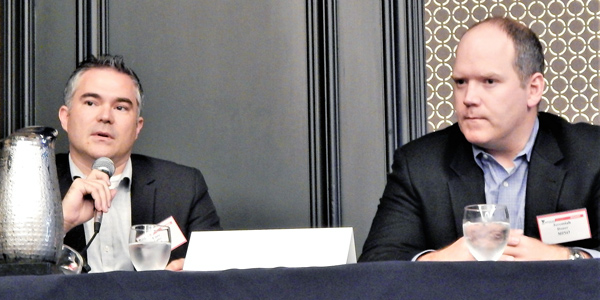MISO, SPP Regulators Mull Seams Recommendations.)
After hearing from MISO’s Jeremiah Doner and SPP’s Casey Cathey, the Seams Liaison Committee (SLC), comprising regulators from the Organization of MISO States and SPP’s Regional State Committee, offered up suggestions on potential SLC actions.
“We need to get serious about starting to prioritize these [recommendations],” said North Dakota Public Service Commissioner Julie Fedorchak, one of the more vocal regulators during the SLC’s web meeting Monday.
Ted Thomas, chair of both the Arkansas Public Service Commission and the SLC, proposed the committee break the recommendations and staff and stakeholder feedback into four buckets: actionable items, further analysis, planning topics and affected-system studies.
Topping the list of actionable items is market-to-market (M2M) coordination, in which the RTOs’ manage congestion by using least-cost generation redispatch. The grid operators have been engaged in the M2M process since 2015, with SPP piling up more than $93 million in settlement payments for congestion on its system caused by MISO.
MISO’s Independent Market Monitor, Potomac Economics, said the RTOs could reap up to $30 million in annual benefits by improving congestion management, noting that many changes would be incremental and only require coordination between the grid operators.
Cathey, SPP’s director of system planning, said the RTOs have been working to improve the process and asked for more time to let the changes take hold.
“If we see still lost opportunities … or reliability concerns after those enhancements are in place, we will have to prioritize some of those [IMM] suggestions,” Cathey said. “We absolutely would like to fix some of the issues we see in market-to-market.”
Potomac’s analysis of interface pricing generated more discussion than any other item. The Monitor viewed the RTOs’ current interface pricing mechanism favorably but noted a flaw in how congestion is charged. FERC Orders Tech Conference on MISO-SPP Congestion.)
Doner, MISO’s director of seams coordination, said the grid operators agree improvements can be made to the pricing mechanism’s design and methodology. He said resolving the issue would require changes to MISO’s market systems, which won’t be fully implemented until 2022. SPP plans to address the issue with a couple of projects that won’t begin until that same year.
“There’s a value to evaluating the interface pricing,” Doner said. “At this point, it’s too early to say what that should be.”
“This is a very complex issue. Whatever we do will take a lot of thinking and additional analysis,” Cathey said. With more than 250 tie lines along the MISO-SPP seam, he asked, “How can you properly send the right signal for imports or exports?”
Potomac President David Patton called in to dispute what he was hearing.
“The overall time frame, the complexity … this has been studied for almost 10 years, including a study on unintended consequences,” he said. “This can be done in a simplified form in a much quicker time frame. The flawed interfacing pricing that exists is generating costs. To say we’re going to leave it for three, four or five years … is not an appropriate action.”
Cathey said it’s a misconception that there’s “a lot of money on the table” and “efficiencies to be gained” by fixing the interfacing pricing. He said ramp limits and make-whole payments for exports are among the issue’s barriers. Both he and Doner said they would be happy to work on interface pricing with the monitors.
“Both RTOs are paying for congestion relief on their neighbor’s system. We’re paying transactors to relieve constraints that neither one has a way to recover, and it ends up being uplifted to the customers,” Patton said. “When people transact at inefficient levels, the overall market results are inefficient and that can hurt generators and load. We should be motivated enough to fix it.”
Doner said MISO stakeholders consider coordinated transaction scheduling (CTS), the third item on the actionable list, to be a low-priority item and have placed its implementation in the Integrated Roadmap process’s parking lot. MISO and PJM have been using CTS on their seam since 2017, he said.
“We’re seeing that the volume of transactions that leverage that product is very small,” Doner said. “What we hear from stakeholders and [transmission] customers is that’s because of transmission service charges and the uncertainty [around] that pricing. Transmission service charges on the PJM seam are even smaller than they are on the SPP seam.”
The RTOs said CTS implementation costs could be as high as $10 million, effectively negating the SPP Market Monitoring Unit’s projection of $9.4 million to $11.2 million in benefits.
The SLC’s leadership has suggested that rate pancaking, unreserved use charges and joint dispatch need further analysis. The monitors’ study on rate pancaking and unreserved use focused on real-time transactions, for which both RTOs already offer heavily discounted transmission service. The analysis did not evaluate the effect on long-term transmission service or day-ahead transactions.
“It would be worthwhile to get [the monitors’] response to those things at some point,” Fedorchak said.
The IMM’s study of joint dispatch found few benefits, noting that dispatching two systems that are already optimized separately yields little incremental production cost benefits. The SLC pointed out that the monitors did not analyze other benefits, such as reliability, reduced unit cycling or reduced reserve margins.
The SLC hopes to present a list of recommendations by the end of 2020 on how the RTOs can improve coordination across the seam.





